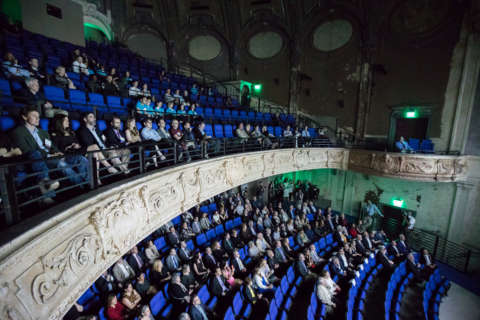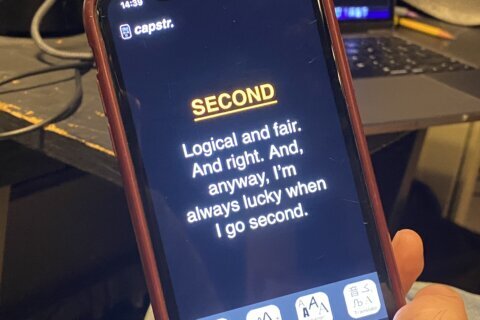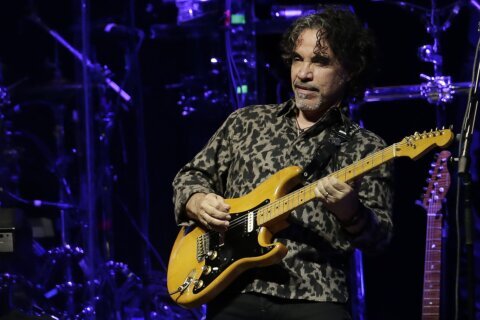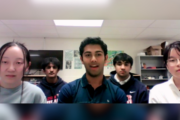If Kenneth Branagh’s remake of “Murder on the Orient Express” (2017) failed to galvanize a new generation, Rian Johnson’s “Knives Out” (2019) undoubtedly revived the comedic whodunnit for a “Glass Onion” sequel.
Streaming platforms followed suit, including Hulu’s “Only Murders in the Building” (2021-present), created by Steve Martin, and Apple’s “The Afterparty” (2022-present), created by Christopher Miller (“The Lego Movie”).
This Wednesday, the Season 2 finale of “The Afterparty” drops on Apple TV+, revealing the killer after 10 episodes where the shifting styles of each chapter are just as fun — if not more fun — than the mystery plot itself.
You’ll recall that last season Detective Danner (Tiffany Haddish) investigated the death of pop star Xavier (Dave Franco), who fell to his death at his swanky mansion the night of his 15-year high school reunion. Danner interviewed Xavier’s former classmates, who woke up the next morning as hungover murder suspects, including Aniq Adjaye (Sam Richardson), who reunited with high school crush Zoë Zhu (Zoë Chao), both of whom were cleared of murder charges.
This season, Aniq and Zoë are dating as they attend the wedding of Zoë’s sister Grace (Poppy Liu) and her fiance Edgar (Zach Woods), who turns up dead. Suspects include Edgar’s mother Isabel (Elizabeth Perkins), his sister Hannah (Anna Konkle), his ex-business partner Sebastian (Jack Whitehall), Grace’s parents Feng (Ken Jeong) and Vivian (Vivian Wu), her eccentric uncle Ulysses (John Cho) and her ex-boyfriend Travis (Paul Walter Hauser).
Like the first season, the best part of “The Afterparty” is that each episode is filmed in a different style or genre, so if you don’t like one episode, just wait 30 minutes until the next chapter to see if that’s more your cup of tea.
Episode 1 is titled “Aniq 2: The Sequel,” exploring Aniq’s perspective in the style of a romantic comedy sequel in which the gang gets back together but is placed in new situations for fresh high jinks. You’ll initially think they scrapped the shifting styles approach because the tone is the closest to reality, except for a few self-aware jokes by Aniq and Danner. Honestly, I wish the filmmakers pushed harder to reference other specific rom coms.
Episode 2 is told from the perspective of the bride, Grace, and is shot in the style of a regency period piece like Jane Austen’s “Pride & Prejudice.” Here, the period costumes are lavish and the romance is sophisticated, albeit with plenty of red herrings. If you like this style, check out the Merchant-Ivory costume dramas like “A Room with a View” (1985), “Howard’s End” (1992) or my personal favorite of the genre, “Remains of the Day” (1993).
Episode 3 is the funniest, shot like a black-and-white Raymond Chandler film noir. Last season, Ben Schwartz stole the show in a musical Episode 3; this year, Hauser shines as Travis, wearing suspenders and a fedora to spit hard-boiled monologues like Philip Marlowe, only with comedy like “Dead Men Don’t Wear Plaid” (1982). Hauser shows he can do it all, from a comedy doofus in “I, Tonya” (2017) to a creepy serial killer in “Blackbird” (2022).
Episode 4 is told from Hannah’s perspective and shot in the twee dollhouse style of Wes Anderson, one of our most recognizable auteurs, particularly the bright paint of the bathroom walls. Hannah most recalls Gwyneth Paltrow’s character in “The Royal Tenenbaums” (2001), my personal favorite Anderson movie, while her outdoor tent recalls “Moonrise Kingdom” (2012). This episode might contain the biggest twists, so buckle up.
Episode 5 is told in the style of a caper flick, specifically a modern slick heist flick like Steven Soderbergh’s “Ocean’s 11” (2001), not a throwback con job like George Roy Hill’s “The Sting” (1973). It’s told from the perspective of Sebastian, revealing secret business deals with the groom that would provide one heck of a motive. It’s probably the most forgettable of the episodes, because I’m having a hard time remembering the details!
Episode 6 is told from Danner’s perspective in the style of a 1990s erotic thriller like “Basic Instinct” (1992), featuring a blue tint and venetian blind shadows painted across the wall. While Haddish has a few funny lines, this episode feels the most like it’s spinning its wheels plot-wise. We really don’t care why Danner got canned from the police force. In fact, it distracts from the murder mystery at hand. You could pluck it out and not miss much.
The plot of Episode 7 is much more consequential, though its genre is harder to recognize, told from the perspective of the “funcle” Ulysses and shot in the style of an epic romance like “Legends of the Fall” (1994). It’s amusing to watch John Cho of “Harold & Kumar” fancy himself as an adventurous swashbuckler — no longer going to White Castle for a burger, but rather riding in on a white horse to save his princess at the castle gates of a wedding.
Episode 8 follows the father of the bride, Feng, with a juicy performance by Ken Jeong, who desperately tries to pitch his idea of Taiwanese shaved ice. We feel really bad for him, but it’s nice to see him as sympathetic after his zany character Mr. Chow. It’s told in the style of the found footage genre, which is mostly associated with horror like “The Blair Witch Project” (1999) and “Paranormal Activity” (2007), but here it’s mostly just voyeuristic.
Episode 9 is told from Isabel’s perspective in the style of Alfred Hitchcock suspense, namely his masterpiece “Vertigo” (1958). The filmmaker paints with neon green light, Perkins is entranced like Madeline/Judy, the camera does dolly/zoom “Vertigo Effect” and hypnotic music recalls Bernard Herrmann. Still, it’s mostly a superficial understanding of Hitchcock, lacking the layers of “Vertigo,” which has the most symbolic direction I’ve ever seen.
Finally, Episode 10 is called “Zoë and Vivian,” cramming two perspectives into one episode, thus exploring two genres — a campy horror movie for Zoë and a 1980s soap opera for Vivian. It’s too much to have dual genres, leaving audiences wishing they explored each genre fully, but let’s face it: This is mostly a capper episode for Danner and Aniq to lay out their case for who they think did it — right as the police officers arrive with handcuffs.
In the end, Season 2 doesn’t feel as fresh or rewarding as Season 1, but it’s still an enjoyable ride where I guarantee you won’t guess the ending (the reveal is too layered with twists and turns to predict). I don’t know how many more seasons Apple can do. After all, how many more events will need afterparties? However, I’m sure I will continue to watch, especially if the writers can continue to find unique film genres and auteur styles to explore.









